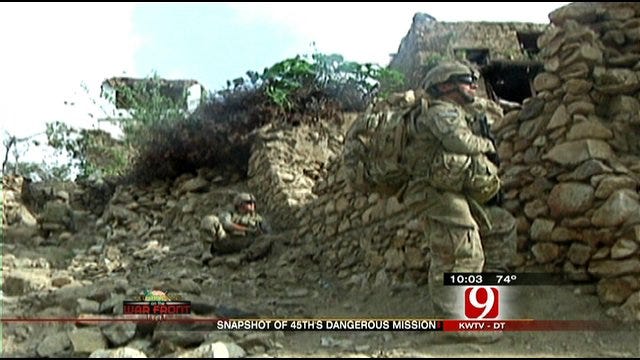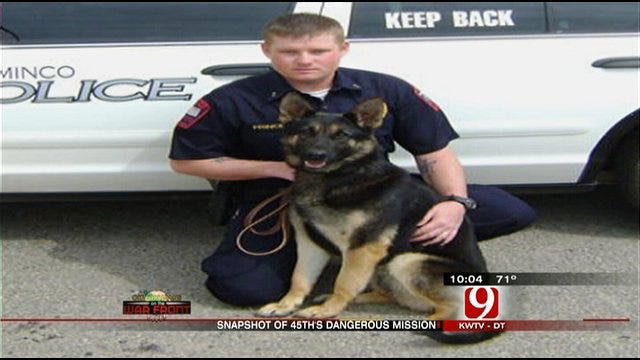Oklahoma Guard Members Give Glimpses Of Deadly Duty
The National Guard tells us the 45th Infantry Brigade is fighting a dangerous mission. Now, we're getting a picture of what the war is like for our hometown heroes.Wednesday, September 28th 2011, 10:25 pm
Michael Konopasek, News 9
OKLAHOMA CITY -- In the past two months, 13 Oklahoma soldiers have paid the ultimate sacrifice. Twelve of them were members of the Oklahoma National Guard's 45th Infantry Brigade.
The National Guard tells us the brigade is fighting a dangerous mission. Now, we're getting a picture of what the war is like for our hometown heroes.
Twelve soldiers in 58 days. That breaks down to about one death every four days. Oklahoma has experienced a tremendous impact since July as Sooner soldiers take on the Taliban in one of Afghanistan's most dangerous areas. Now, a dozen families are left without a father, a brother or a son.
We're now learning why there are so many Oklahoma casualties. Pictures and narration released Wednesday give a glimpse of the 45th sweeping through eight villages in southeast Afghanistan where an army specialist describes the Taliban loyalty as fierce as the rocks are jagged.
Second Lt. James Brown remembers the first night in enemy territory, saying, "Looking up at the mountain tops, we knew we were in a little bit of trouble. We knew we probably shouldn't have been there."
Lt. Col. Max Moss of the Oklahoma Army National Guard says the members of the 45th are well-trained and performing their mission well.
"The 45th is engaged with the Taliban, either trying to kill or capture Taliban, and that's very dangerous work," said Moss. "By all accounts, they're doing a really good job."
But, the 45th's success comes at a cost. An army specialist remembers a deadly night earlier during the week of Sept. 25th saying, "even as the soldiers pressed their way upwards into the village's cornfields, the first rocket-propelled grenade hit from a ridge above, followed by another. A hailstorm of small arms fire followed."
That was the scenario that killed Sgt. Mycal Prince who was a police officer, husband and father of two girls.
About 2,200 Oklahoma National Guardsmen are serving in Afghanistan as American casualties have increased over the past two years.
"The soldiers are performing their mission very well," said Moss.
An army specialist stationed with the 45th released an article about the challenges Oklahoma soldiers are facing. That article is published below.
_______________________________________________________________________
Written by U.S. Army Spc. Tanangachi Mfuni, 7th Mobile Public Affairs Detachment
LAGHMAN PROVINCE, Afghanistan -- Over a period of five gruelling days and nights in September, one Oklahoma National Guard infantry unit was tasked to venture deep into Taliban territory.
The Soldiers from Company A, 1st Battalion, 179th Infantry Regiment, 45th Infantry Brigade Combat Team out of Stillwater, Okla., together with Afghan National Army (ANA) Soldiers, swept through eight villages in southeast Afghanistan's remote Saygal Valley as part of Operation Brass Monkey. Located in Laghman Province, Saygal is a place where Taliban loyalty is as fierce as the rocks are jagged.
Opposition towards coalition forces runs so deep in the Saygal Valley that Afghanistan's International Security Assistance Force (ISAF) hasn't ventured into the area in eight years.
Under a midnight moon, 3rd Platoon, commanded by 2nd Lt. James Brown, an Oklahoma National Guard Soldier from Binger, Okla., was inserted by helicopter on a ridge opposite the mission's first objective—a lofty village surrounded by golden terraces of corn.
The CH-47 Chinook helicopter carrying Brown's platoon and the group of ANA Soldiers, commanded by 1st Lt. Mohammed Agha, the proud son of an ANA colonel, touched ground with both leaders knowing from Taliban radio chatter that the enemy already had eyes on the team.
"The first night, looking up at the mountains tops, we knew we were in a little bit of trouble," said Brown. "We knew we probably shouldn't have been there."
Afghan and American Soldiers hastily stacked loose boulders, building fortified fighting positions, before making their beds on stony ground, using rocks as pillows.
The team rose before sunrise and began to navigate a hazardous route down one peak and up another, just to reach the first of eight villages. They picked their way down a 15-story drop, lined by unforgiving boulders that made a treacherous staircase to a riverbed below.
"If I die falling off the side of a cliff, tell Rick I love him," newlywed Spc. Erica Watkins, of Sapulpa, Okla., said of her husband, as her five-foot-two frame gingerly slid down a boulder.
Watkins was one of two female Soldiers in the Female Engagement Team, who traveled with the infantrymen. These teams are responsible for interacting with, and if need be, searching, Afghan women during missions like Brass Monkey.
After a pit-stop at the river below, the team geared up again, this time to ascend to their first objective.
The trail up to the village was moderately steep but appeared well traveled, dotted with ruby-red pomegranate seeds.
As they neared the village outskirts, the team took a break. Heavily laden with a two-day supply of food and water, machine guns and ammo, in back-breaking loads that easily weighed up to 70-pounds, the Soldiers were glad for a chance to catch their breath. As they rested, they spotted three men observing them from the ridge opposite to their current location.
"We've gotta get out of here," someone said, suspecting an ambush. Even as the Soldiers pressed their way upwards into the village's cornfields, the first rocket-propelled grenade hit from a ridge above, followed by another. A hailstorm of small arms fire followed.
Sgt. Mycal Prince was killed instantly. The 28-year-old Oklahoma National Guardsman, who worked as a policeman in the K-9 unit of the Minco Police Department, was a husband and father of two girls.
A 19-year-old, baby-faced Afghan Soldier named Amanullah was also wounded in the attack, taking a bullet through the thigh that narrowly missed his femoral artery.
The ambush came as a shock to Agha.
"It's my first time to come face-to-face with the Taliban," said the ANA commander who has been in the Afghan Army for nearly four years, "It's my first time to lose one of my men."
While Amanullah survived the gunshot wound, his condition was critical.
The firestorm of bullets between the Soldiers and their attackers continued until an air weapons team of helicopters arrived on scene, laying down ground-shaking munitions that killed several members of the ambush.
Over the next two hours, U.S. and Afghan Forces set-up security in cornfields as Brown requested a medical evacuation for eight casualties, including his medic.
While medevac helicopters came for the casualties, there was no relief for the rest of Brown's battle-fatigued team. Instead, they were asked to do what seemed impossible—continue the mission.
"Don't stop until we reach the bottom," Brown urged his team as they made their way downhill over treacherous rocks.
Over the next 100 hours, Brown's platoon, together with the rest of Company A and their Afghan partners, would continue the mission, and comb Saygal Valley for insurgents.
The company of Soldiers navigated peak after peak as they moved through Saygal's villages. As they entered the valley's hamlets they held shuras, or meetings, with elders, some of whom said they had not seen any military presence since the 1979 Russian invasion. The Soldiers collected biometric information from scores of military aged men, detaining three with suspected Taliban ties.
Most importantly, Company A killed ten insurgents including a mid-level Taliban commander who was on the battalion's most wanted list. Two weapons caches were also discovered. "We took some bad guys out of the game, we took some of their equipment and ordnance out of the game," said Capt. Jason Taylor, Oklahoma City, Company A commander. "I think it's good to take those bad guys out of the villages and let them know [the insurgents] are not safe, even in the farthest reaches."
Looking at the Soldiers of Company A, it was evident they had been to the farthest reaches. After five days of patrolling through the treacherous terrain, engaging the enemy, and searching through eight villages, the Soldiers were covered in layers of sweat and dirt. Many of their uniforms were tattered and torn, exposing their tired limbs beneath.
"They performed excellently," Taylor said of his Soldiers, "I really couldn't ask for anything better."
Staff Sgt. Edward Johnson of Tulsa, Okla., said Brass Monkey's success had come at a high cost, a sentiment echoed throughout the company.
"The worst part of this mission," said Johnson, "the part that everybody's going to remember is we lost one of the best men we had."
More Like This
September 28th, 2011
January 2nd, 2025
September 29th, 2024
Top Headlines
April 16th, 2025
April 16th, 2025










